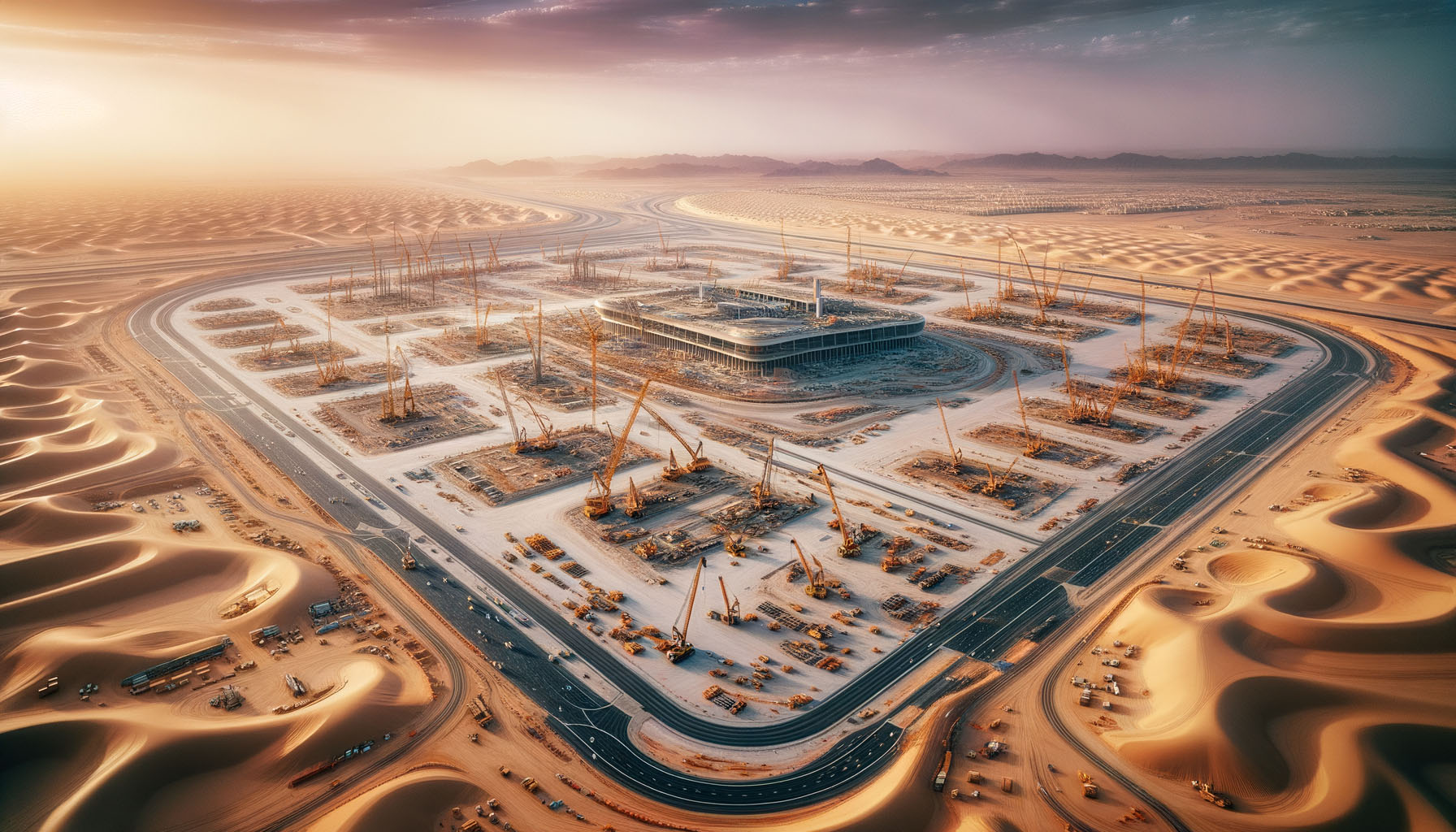
Construction of the world's largest airport has begun in Saudi Arabia, with opening scheduled for 2030.
Saudi Arabia is entering a new era of aviation and tourism development with the start of construction of the world's largest airport, King Salman International. This ambitious project, scheduled for completion by 2030, promises to boost air travel and attract millions of tourists to the country. The new airport is part of the ambitious “Vision 2030” program aimed at diversifying Saudi Arabia's economy and reducing its dependence on the oil sector. The government sees tourism development as one of the key drivers of economic growth in the coming decades.
Scope and features of the project
- The size and location of the airport.
“King Salman International” will be located in the capital city, Riyadh, and will cover an area of more than 57 square kilometers. This makes it almost twice the size of the current record holder, King Fahd International Airport in Dammam. The grandiose size of the airport will accommodate extensive infrastructure, including six parallel runways, spacious terminals, hotels, shopping plazas and a dedicated area for private aviation. - Capacity and Infrastructure.
According to preliminary estimates, King Salman International will be able to handle up to 120 million passengers annually by 2030, and this could rise to an impressive 185 million by 2050. By comparison, the world's largest airport to date, Hartsfield-Jackson in Atlanta, USA, handled around 110 million passengers in 2019. The new airport's infrastructure will include terminals totaling 12 square kilometers, more than 400 hotel rooms and extensive retail space. This scale will create a real “aerotropolis” — a city inside the airport where passengers can comfortably spend time between flights. - Advanced technology and sustainability.
“King Salman International” is planned to be equipped with the most advanced technologies that will make passengers' stay at the airport as comfortable and efficient as possible. This includes automated baggage handling systems, biometric passenger identification to speed up security and check-in procedures, as well as intelligent navigation and information systems. In addition, special attention is paid to environmental sustainability in the design and construction of the airport. Energy-efficient solutions, water recycling systems, solar panels and other “green” technologies will be used to minimize environmental impact.
Economic significance of the project
- The airport's role in the Vision 2030 program.
The construction of King Salman International is a key element of the Vision 2030 program, which aims to transform Saudi Arabia into a global transportation and tourism hub. The new airport is set to become a gateway to the country for millions of tourists and business travelers, as well as an important transit hub at the crossroads between Europe, Asia and Africa. The development of the tourism sector, in turn, is intended to stimulate economic growth, create new jobs and attract foreign investment. Saudi Arabia's ambitious plans envisage increasing the share of tourism in the country's GDP to 10% by 2030. - Job creation and contribution to GDP.
The construction and subsequent operation of King Salman International will create thousands of jobs in sectors ranging from construction and engineering to passenger services and air traffic control. This will help reduce unemployment and improve living standards. Experts predict that by 2050, the airport could provide up to 5% of Saudi Arabia's non-oil GDP. This is a significant contribution to diversifying the country's economy and reducing its vulnerability to oil price fluctuations.
Install our app and get all the tools you need to search for real estate abroad in your smartphone! The mobile application will allow you to quickly access your personal account, manage your favorite properties and track your requests, directly exchange messages with sellers and buyers.

4. Challenges and Prospects
- Transportation Infrastructure Development.
One of the key challenges of the project is the need to develop adequate transportation infrastructure to connect the airport with Riyadh and other cities in the country. This will require significant investment in the construction of new highways, railroads and public transportation systems. Saudi Arabia is already implementing a number of large-scale infrastructure projects, including a high-speed railroad between Mecca and Medina, which may be extended to the new airport in the future. - Providing qualified personnel.
Another important challenge is to train a sufficient number of qualified people to work at the airport. This will require significant investment in education and vocational training, as well as the involvement of foreign experts in the initial stages. Saudi Arabia is already taking steps in this direction by developing cooperation with the world's leading aviation universities and establishing its own training centers. - Environmental aspects of construction.
The construction of an airport of this scale will inevitably have an impact on the environment. It is important to ensure that the negative impact is minimized through the application of environmentally friendly technologies, rational use of resources and restoration of affected ecosystems. Saudi Arabia is committed to sustainable development and plans to make King Salman International a model of sustainability among the world's airports.
Test period and full-scale launch
The airport is expected to operate in a test period for the first 12 months after completion in 2030. This will allow all systems and processes to be fine-tuned, infrastructure to operate smoothly and passenger flows to be optimized. Following the successful completion of the test period, King Salman International will move to full-scale operations, gradually increasing the number of flights and passengers served.
6. Significance for the global aviation industry
The construction of King Salman International is not only an important step for Saudi Arabia, but also a significant event for the entire global aviation industry. This project has the potential to become a new benchmark for airports of the future, combining advanced technology, environmental sustainability and an impressive scale of infrastructure. Successful realization of the project will demonstrate the potential of an innovative approach to the development of the aviation industry and inspire other countries to create similar facilities.7. Conclusion: The airport of the future is becoming a reality.
The King Salman International project is Saudi Arabia's bold step into the future of aviation and tourism. The world's largest airport promises to become not just a transportation hub, but a true center of attraction for travelers from around the world. The scale and technological innovations incorporated into the project demonstrate Saudi Arabia's ambition to lead the aviation industry and develop sustainable tourism. The successful realization of this ambitious plan could be a catalyst for economic growth and diversification of the country's economy.
Of course, there are still many challenges to overcome on the way to making the project a reality, from developing transportation infrastructure to ensuring environmental sustainability. However, the determination and resources that Saudi Arabia is investing in the construction of King Salman International give hope for a successful outcome. The global aviation industry is watching the development of the project with interest, as it could set new standards for airports of the future. Saudi Arabia's experience in creating an ultra-modern and environmentally friendly aviation hub will be useful for other countries seeking to modernize their transport infrastructure.
The opening of King Salman International in 2030 promises to be a truly historic moment. This megaproject epitomizes humanity's quest to conquer new horizons and create innovative solutions to develop global connectivity. The airport of the future is gradually becoming a reality and Saudi Arabia is at the forefront of this process.
We can only look forward to the completion of construction and the first flights that will open a new page in the history of global aviation. “King Salman International” promises to become not just another air harbor, but a symbol of technological progress, sustainable development and the limitless possibilities of human creativity.

In 2025, the rental market in Germany is undergoing major changes. Tightening energy efficiency requirements, a reform of the social benefits system, the possible abolition of controversial fees and growing demand against a backdrop of limited supply are all creating a new reality for tenants and landlords. We look at the causes, consequences and prospects for these changes.

Albania is experiencing an unprecedented tourism boom that is not only attracting record numbers of foreign visitors, but also stimulating the rental market and generating significant revenue for the government. The increase in tourism is transforming the country’s economy and creating new opportunities for both locals and foreign investors.

In Germany, the new government has announced major changes to migration policy. The accelerated scheme for obtaining citizenship in 3 years is cancelled, restrictions on family reunification and the acceptance of refugees are introduced, and border controls are tightened. We talk about the essence of the reforms, their reasons and impact on migrants and German society.



